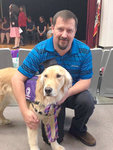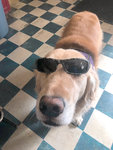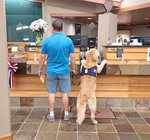Clear, 68° F
Russell Stafford closed his eyes and nervously searched for the right words to describe the moments leading up to the tragic accident that would haunt him for years to come. Though he served as a …
This item is available in full to subscribers.
The Powell Tribune has expanded its online content. To continue reading, you will need to either log in to your subscriber account, or purchase a subscription.
If you are a current print subscriber, you can set up a free web account by clicking here.
If you already have a web account, but need to reset it, you can do so by clicking here.
If you would like to purchase a subscription click here.
Please log in to continue |
|





Russell Stafford closed his eyes and nervously searched for the right words to describe the moments leading up to the tragic accident that would haunt him for years to come. Though he served as a combat engineer in war zones from the Balkans to the Middle East, his life-threatening injuries happened during a night training exercise in California.
The U.S. Army sergeant was in a Humvee, escorting a tank in need of repairs back to the shop at the Ft. Irwin National Training Center. Driving without lights due to the mission, the Humvee became stuck in a ditch. The modified M60 tank, unable to see the stuck vehicle, rolled over Stafford, nearly costing him his life.
Stafford suffered head and back injuries, permanently changing the course of his life. Damage to his spinal column, which blocks all feeling to his legs, and traumatic brain injury were the physical prognosis. It was a long road back, but he would eventually move forward, although permanently disabled. Emotionally, he was in tatters.
Exiting the military after about a decade of service, Stafford returned to civilian life and immediately proceeded to fail.
“I was really messed up,” he said, not really wanting to relive the tough times.
“It took me going through a marriage, divorce and another marriage before actually seeking help.”
Soldiers struggling to adjust to life as civilians after military service is common. There’s often a loss of identity and a feeling of not fitting in. There is a sense of camaraderie that comes with the experiences shared in the military that is almost impossible to replicate outside the service. Those returning to civilian life with life-altering injuries and emotional trauma have an even tougher fight to find some semblance of normalcy.
Finding canine companionship
Years later Stafford was in Reno, Nevada, attending a veteran’s event. His life was a mess. While there he saw fellow wounded warriors accompanied by service animals and was intrigued. He hadn’t had a dog since childhood and was inspired after seeing the dogs work to support their partners.
It took more than three years for Stafford to find an organization willing to train and match him with a suitable service dog. He needed physical support as well as emotional comfort.
Paws for Purple Hearts, a nonprofit organization matching veterans with mobility and trauma-related conditions like TBI and post-traumatic stress disorder, had spent the three years training Stafford’s service dog for more than 250 commands.
“To this day, I still don’t know all those commands,” he said.
It was time for the veteran to be trained. He was tethered to the fluffy, friendly golden retriever named Major 24-hours a day for the first three days, followed by another 10 days of training. The organization’s diligence is intense, both prior to approving requests and matching service dogs with veterans in need.
There is no room for failure after the organization spent more than $35,000 to train the animal, which they named Major.
Ambassador of love
After a long period of acclimating to life with a four-legged, 90-pound roommate, Major and Russell became best friends. Major’s patience and loving-nature is typical of the breed, but there was more to this dog. Major could sense when someone near him was in pain and would share his love with anyone in need.
There was something about Major that had a reassuring effect on even the hardest souls to reach. Stafford, who has always tried to serve his fellow man, started to share Major with the community.
As the commander of American Legion Post 26, Stafford knew there were many veterans in the Basin who were hurting. He formed a support group called Battling 22.
The name of the group points to a shocking statistic in America. According to a report published by the United States Department of Veterans Affairs, which analyzed 55 million veterans’ records from 1979 to 2014, indicates that an average of about 22 veterans are lost to suicide every day.
Earning the trust of veterans is not an easy task. But Major brought a sense of calm with his kind eyes and gentle nature, transforming hardened soldiers, said Patty Paulson, president of the American Legion Auxiliary at Post 26.
She was at the post to give a ride home to a soldier attending the session who rarely, if ever, spoke of his difficulties after his service. She was surprised to find him there sharing his story.
“He was sitting there petting Major and just talking away,” she said. “Major has that effect on people.”
Paulson also works with disabled clients at Big Horn Enterprises, Inc., a company caring for residents with disabilities. She decided to ask Stafford if he could bring Major to the facility. The happy pup was an instant hit with clients — even those previously afraid of dogs.
“I have a client that is scared to death of dogs. But he grew to love Major,” she said. “It’s hard to put into words, but I’ve never met a dog like that. There isn’t a person that doesn’t love that dog.”
Soon Stafford and Major were visiting at least twice a week, comforting clients in dire need of Major’s special class of affection. Stafford then began sharing Major with others in the community.
Renée Hanlin, children’s librarian with the Park County Library System, teamed up with Stafford for a program called Read to a Dog. Twice a month Major and Stafford would come to the Powell Library to find children waiting.
“It was a safe place for children to read without being evaluated,” Hanlin said. “You know, sometimes kids don’t like to read aloud.”
Reading to Major gave children confidence, said Jane Foley, an assistant at the branch.
“A lot of parents have told us over the years, that [the program] really improved their child’s reading,” she said.
His ability to find those in need of special attention didn’t stop with the children, Hanlin said.
“I think that both I [and other employees] had experiences where we were stressed or weren’t feeling very well. Major knew it and would come to us. He was very sensitive to people.”
A new challenge
There are too many stories of Major’s ability to heal — from working with autistic children to being an ambassador of love everywhere he went — to mention here. For years people sought him out, but it was time for Major to retire.
Stafford recently began the process of securing another service animal as Major neared his 10th birthday.
The plan was to have the dogs overlap, allowing Major to assist in the training for Stafford’s special physical needs. But then Major was diagnosed with Cutaneous T-cell lymphoma, a rare type of cancer that begins in white blood cells. Shortly after the diagnosis Major died.
The news of Major’s death two weeks ago has been met with sadness in the community.
“Everyone was devastated,” Paulson said. “He has changed a lot of people’s lives. He was more than just a service dog. He was a friend.”
“He has been missed,” Foley said. “We’ve had a lot of people ask about him here.”
Stafford is trying to be strong, but two weeks later he’s back to using crutches, which he handn’t had to use with Major’s help, and said he feels lost. He fought back tears as he spoke about his respect for Major.
“I had never said please and thank you to a dog before,” he said. “There’s a hole in my life right now.”
Friends have been worried, calling often to see if they can help.
“We’ve all been kind of keeping an eye on Russell,” Paulson said. “I told him, you know, Major worked too hard to rescue you from that dark place. You don’t want to go back.”
Paws for Purple Hearts will provide Stafford with a new service dog this coming spring. A new pup in the house often soothes the pain of the loss of a beloved pet, but Stafford said it will take a while to replace his “best friend.”
He understands that many will want to meet his new service dog, but cautions friends and members of the community that, even after he receives the canine, it could take between six months and a year before he can allow it to interact with others while the two bond.
The mourning process will be hard. Stafford plans to spread Major’s ashes under an apple tree.
“He loved apples,” he said.
For more information about Paws for Purple Hearts or to donate: pawsforpurplehearts.org